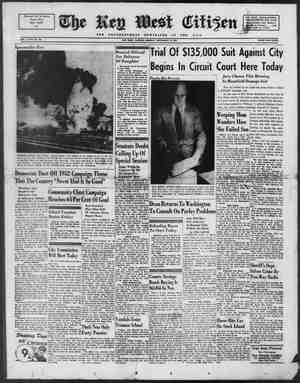The Key West Citizen Newspaper, December 14, 1953, Page 8
You have reached the hourly page view limit. Unlock higher limit to our entire archive!
Subscribers enjoy higher page view limit, downloads, and exclusive features.
Visitor Fails To Recognize Modern Key West After 51 Year Absence By DENIS SNEIGR How much does a town change in 51 years? Plenty, in the opinion of Harry C. Stalley. The 70- year-old Stalley, who looks more like 50, walked into The Citizen office and laid down a fat album of photos. “This is the first time I've been in Key West since 1902,” he said. “The only things I recognize are a few buildings that were standing then.” He thumbed through the album to a photo of the hotel where he stayed when he was here in 1902. It was then known as the Hotel Jefferson, he recalled. Now it is the Tropical Hotel at 114 Duval. A street car line ran on Duval then and the photo shows one of the trolleys in front of the hotel. The general outlines of the hotel are the same to- cay. In 1902, the hotel sported a tower and first and second floor balconies. The balconies have been enclosed now and the tower wes removed. Then it was a frame bullding. Now it has been plastered over with stucco. Stalley came to Key West on the railroad that year, the same year that the Cuban republic was inaugurated and the American occupation of the island under Gen. Leonard Wood ended. That year also saw the sending of the first radio message on Dec. 21, Stalley’s 1902 trip to Key West was brief—only a week or so. He was enroute from Cleveland, Ohio, his birth place, to the Dry Tortugas. _Stalley, a retired civil engineer, was enroute to Tortugas for the Brown Hoisting Machinery Co. to help erect coal handling equipment there for the Navy. Dry Tortugas then was a coaling station for Navy ships. He recalled that he and his fellow workers returned from Tortugas in a two-masted schooner. The trip back to Key West took 48 hours because of the calm weather. Finally, about a mile off Key West, the wind quit altogether. “We had used up all our provisions,” he said. “We could see the Island lying there but not a breath of air stirred to push ashore. “We finally rowed into Key West,” he added. Stalley, who now lives in Fort Lauderdale, was here on a two-day visit. With him were his wife and the Rev. Willis S. Rowe, a retired minister, and Mrs. Rowe. VOUT OFFICE BUILDING in 1902 was one of the largest structures ARMY BARRACKS have long since disappeared. They stood where Peary Court now stands, Peary Court is a Navy housing project for enlisted men. Many Key Westers played ball here when they were boys. Witrtrermenettemwe tr ee ~ HARRY C. STALLEY (right) points out interesting photos to Denis Sneigr, Citizen staffer. Stalley last visited Key West 52 years ago when he took most of the photos on this page. FORT JEFFERSON, on Dry Tortugas, was a golng concern in 1902, The Navy used the island as a coal- ing station. This photo, like the old views of Key West on this page, was taken by Harry C. Stalley when he visited the city 51 years ago. SPORGING WAS BIG BUSINESS IN KEY WEST shortly after the turn of the century, as Mese two photos of te Dustling sponge GOCKS snow. Em me pmowe ge he top of the city hall tower can just barely be seen above the intervening buildings. in Key West. The building, near Whitehead and Greene Streets, is used today by the Navy as an office building. LEADING HOTEL IN 1902 { stucco. A street car ] Tropical Hotel, 114 Duval Street (right): The verendahs and@ the tower were removed, and the bu. g Was given a coarng
